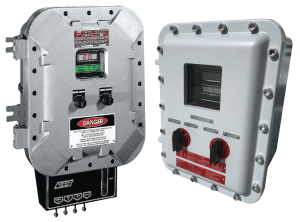
For Sales / Support Call / Email:
+91 20 26930908 / 26930960 / 61 Sales@steamequipments.com
Explosion Proof Percent Oxygen Analyzer

The Model 3020P is a versatile microprocessor-based instrument specifically designed to detect oxygen in a variety of gases. It is a precise, cost effective instrument capable of measuring percent oxygen in as low as the 0-1% range. Drawing on the solid performance of the 3000 series control platform, the 3020M provides the user with a wide variety of features and options to satisfy virtually any application.
Paramagnetism
The physical property distinguishing oxygen from other gases is its paramagnetism, which is significantly greater than other common gases. Consequently, the molecules of oxygen are attracted by strong magnetic fields which can be used in detection. The sensor consists of two spheres arranged in the form of a dumbbell suspended in a symmetrical, non-uniform magnetic field. When the surrounding gas contains oxygen, the spheres rotate out of the magnetic field by the relatively strong attraction of oxygen. A light beam focused on a mirror attached reflects asymmetrically onto two photo diodes resulting in a voltage shift. The difference of this produces a current used to drive the dumbbells back to the original position. The current flow required to maintain the null position is directly proportional to the oxygen concentration and is shown linearly in volume percent oxygen in the display. Properly maintained sensors last for years with little or no attention making them ideal for critical measurements in the low percent range.
Flexibility
This unit offers three dynamic, user-configurable ranges plus auto ranging and can be calibrated in any range. It is linear on all three ranges, eliminating the need to recalibrate while switching between ranges. This analyzer comes standard with an isolated 4-20 mADC output for oxygen concentration and range identification. Additionally, a bi-directional RS-232C serial communication interface provides for remote monitoring and control of span and zero functions.
Additional Advantages
• Linearity of analysis across three user-selectable ranges
• Auto-ranging to follow process upsets
• Auto-calibration electronics standard
• No purge gas requirements
Options
C Electronically operated cal/zero valves
F Flame arrestors for Class 1, Div 1, Group C/D service
G Flame arrestors for Class 1, Div 1, Group C/D service with cal valves
H Flame arrestors for Group B (hydrogen) service
I Flame arrestors for Group B service with cal valves
Sample Gas Conditioning Requirements
• Sample Inlet Pressure: 5 to 20 psig (regulate to fixed inlet pressure)
• Sample Flow: 1 to 2 SCFH
• Sample Dewpoint: Non-condensing at ambient temperature
• Sample Temperature: 32° to 122°F (0° to 50°C)
• Detector Wetted Parts: Glass, steel, gold, Viton, acrylic glass and epoxy resin
• An explosion proof NEMA 4/7 rated enclosure
• 2-line alphanumeric display screen, driven by microprocessor electronics continuously prompting and informing the operator
• High resolution, accurate readings of oxygen content from low ppm levels through 100%
• Advanced Micro-Fuel Cell designed for trace analysis, with a one year warranty and an expected life of two years
• Versatile analysis over a wide range of applications
• Microprocessor based electronics: 8-bit CMOS microprocessor with 32 kB RAM and 128 kB ROM
• Three user-definable output ranges (from 0-1% through 0-100%) assuring a perfect match for the user’s process
• Air-calibration range for convenient spanning at 20.9%
• Auto-ranging automatically selects the proper preset range for a given measurement. Manual override allows the user to lock onto a specific range of interest
• Two adjustable concentration alarms and a system failure alarm
• Extensive self-diagnostic testing at start-up and on demand with continuous power-supply monitoring
• Two way RS-232 serial digital port for use with a computer or other digital communication device
• Four analog outputs; two for measurement (0-1 VDC and isolated 4-20 mADC) and two for range identification
• NEC and ATEX rated configurations
Ranges | 3 customer programmable ranges (minimum 0-1%) with auto-ranging |
Accuracy | ± 2% of FS at a constant temperature |
Sensitivity | 0.5% of FS |
Response Time | (B-1) 90% of FS at 77°F (25°C) in less than 10 seconds |
Temperature | 32° to 122°F (0° to 50°C) |
Output | Signal: Analytical measurement 0-1 VDC |
Display | Analysis: 5 digit red LED, 3/5″ high numerals |
Alarm | One system failure alarm contact to detect power failure |
Power | 115 to 230 VAC, 50/60 Hz |
Sensor | Teledyne Micro-Fuel Cell, Class B-1 |
Classifications | Explosion proof enclosure is U/L and CSA listed for Class 1, Div 1, Group B, C & D service NEMA 4/7 rated |
Dimensions | 25.63″H x 15.25″W x 11″D |
This instrument is designed specifically for the detection of percent oxygen in petrochemical applications for process control, quality assurance and safety related purposes. Typical petrochemical plants requiring this unit are:
• Ethyl Benzene / Styrene Monomer (EB/SM)
• Pure Terephthalic Acid (PTA)
• Caprolactum
• Phenol / Cumene
• Polycarbonate
• Polyethylene
• Polystyrene
• Ethylene Oxide / Ethylene Glycol (EO/EG)
• Methyl Methacrylate
• Ammonia / Urea Fertilizer
• Refinery FCC unit and flare gas applications
• Marine Vapor Recovery (MVR)
© 2020. Steam Equipments Pvt Ltd. All Rights Reserved.